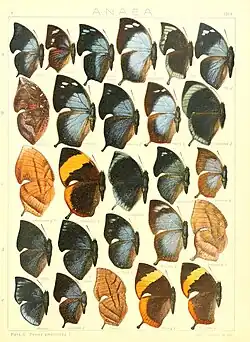Memphis lineata
| Memphis lineata | |
|---|---|

| |
| Scientific classification | |
| Kingdom: | Animalia |
| Phylum: | Arthropoda |
| Class: | Insecta |
| Order: | Lepidoptera |
| Family: | Nymphalidae |
| Tribe: | Anaeini |
| Genus: | Memphis |
| Species: | M. lineata
|
| Binomial name | |
| Memphis lineata | |
Memphis lineata is a species of leafwing found in South America (Colombia, Bolivia, Ecuador, Brazil and Peru).[2]
Memphis lineata is a butterfly with a wingspan of about 58 mm, with forewings with a humped costal edge, pointed apex, concave outer edge near the apex, hooked inner angle and concave inner edge. Each hindwing has a tail that is sometimes very minimal. The upper part of the male is slate blue with a slate blue basal part on the forewings and the majority of the wing almost black with a few blue spots near the apex and the slate blue hindwings with the dark grey apex. Females are light brown with a purple basal suffusion. The reverse side is golden beige to greyish-brown and simulates a dead leaf. Seitz- a species of very different sexes. The upper surface of the female resembles that of a schausiana (120 C a), but it has a fainter blue decoration, especially on the hindwing and the apical part of the forewing is without spots. The under surface is marked like in indigotica (120 Cb), of which it has also the faint hue of violet- pink which is spread across the under surface and is of an especially magnificent lustre in the sun.[3][4] [5]
Biotope - Memphis lineata lives at altitudes up to 3,000 m.
References
- ^ Salvin, O. 1869 Description of new species of butterflies from tropical America Ann. Mag. nat. Hist. (4)
- ^ *Savela, Markku (April 7, 2019). "Memphis Hübner, [1819]". Lepidoptera and Some Other Life Forms. Retrieved July 13, 2025.
- ^ Comstock, W. P.1961. Butterflies of the American Tropics: the genus Anaea. Lepidoptera, Nymphalidae. New York: Amer. Mus. Nat. Hist. 214pp,30pl.
- ^ D'Abrera, B. 1988. Butterflies of the Neotropical Region, Nymphalidae, Satyridae. Victoria: Hill House. Pp. 680-723.; present in Mexico, Guatemala, and Panama.
- ^ Julius Rober ANAEA in Seitz.A. Band 5: Abt. 2, Die exotischen Großschmetterlinge, Die Großschmetterlinge des amerikanischen Faunengebietes, 1907 580 et seq.
 This article incorporates text from this source, which is in the public domain.
This article incorporates text from this source, which is in the public domain.